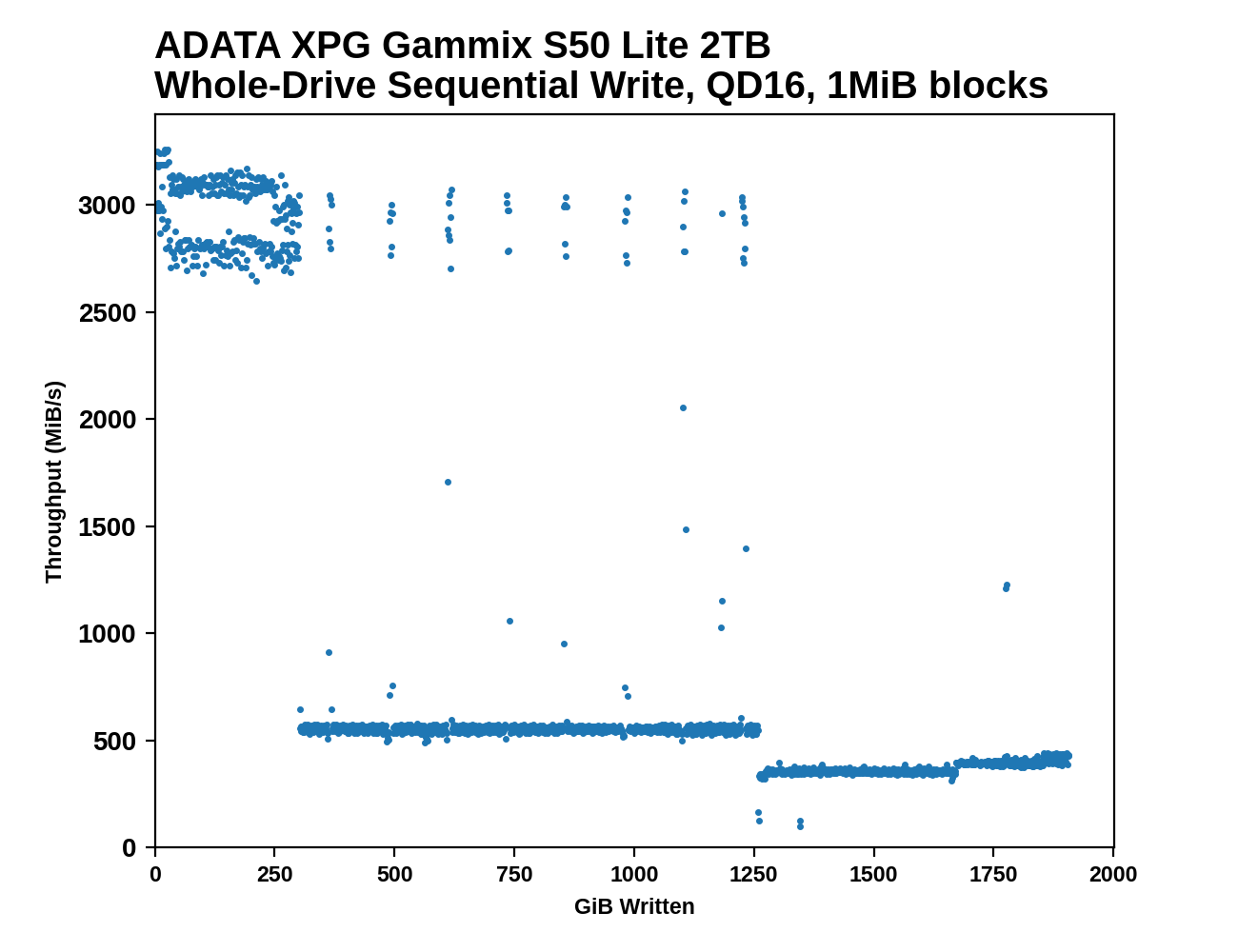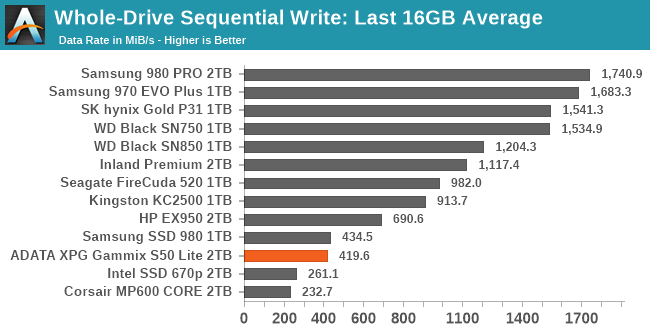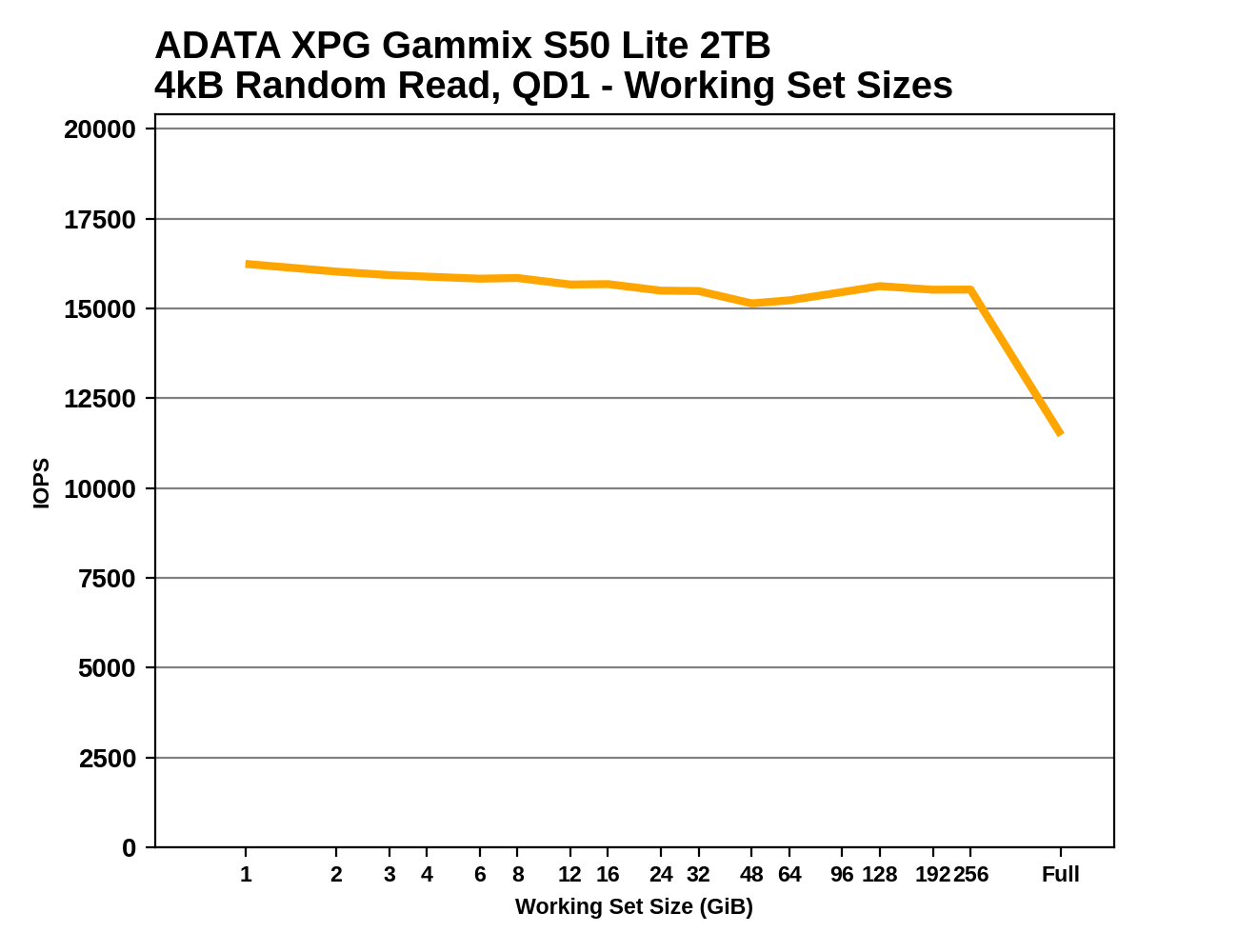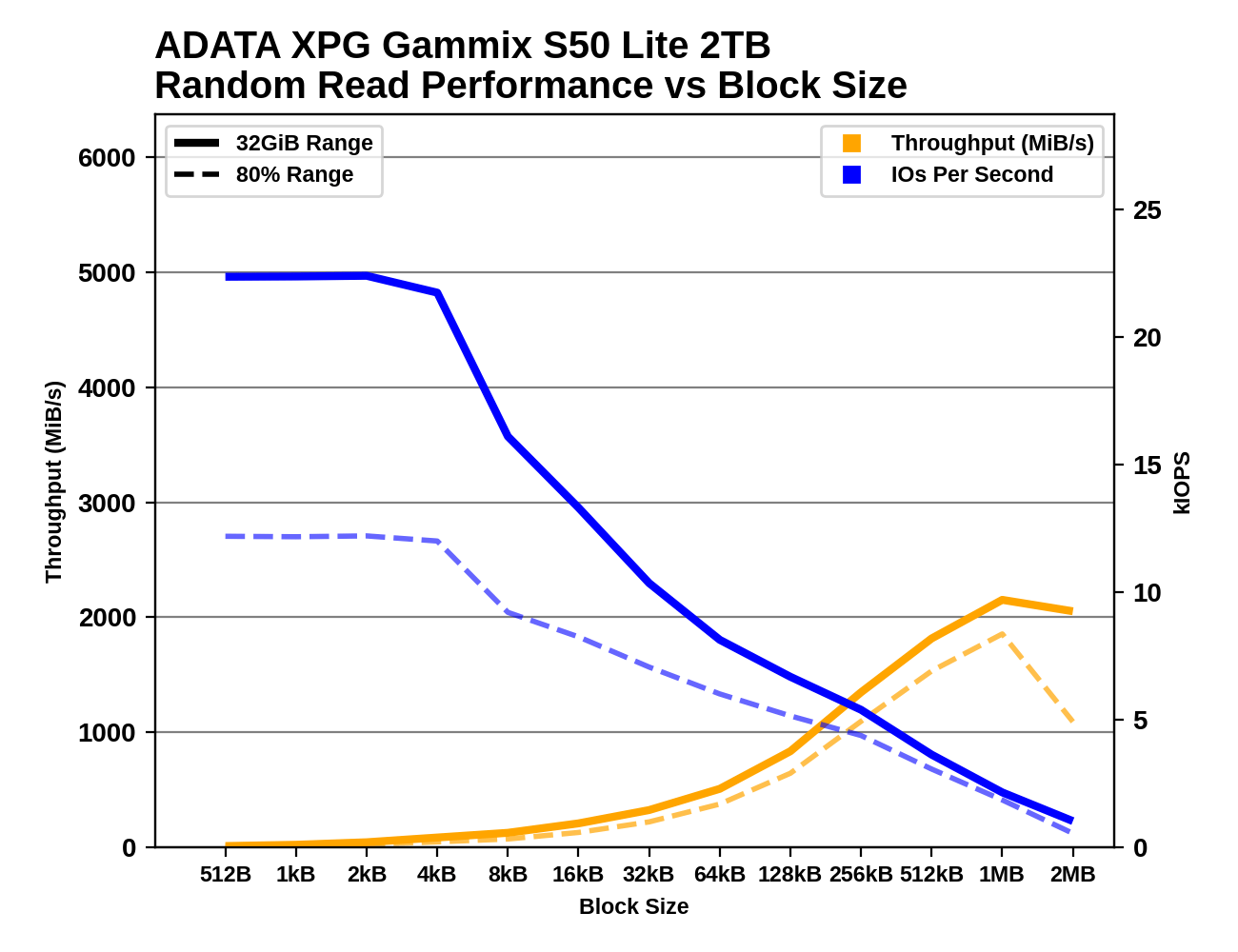The ADATA GAMMIX S50 Lite 2TB SSD Review: Mainstream PCIe Gen4
by Billy Tallis on April 30, 2021 8:00 AM ESTAdvanced Synthetic Tests
Our benchmark suite includes a variety of tests that are less about replicating any real-world IO patterns, and more about exposing the inner workings of a drive with narrowly-focused tests. Many of these tests will show exaggerated differences between drives, and for the most part that should not be taken as a sign that one drive will be drastically faster for real-world usage. These tests are about satisfying curiosity, and are not good measures of overall drive performance. For more details, please see the overview of our 2021 Consumer SSD Benchmark Suite.
Whole-Drive Fill
 |
|||||||||
| Pass 1 | |||||||||
| Pass 2 | |||||||||
The ADATA XPG Gammix S50 Lite shows an almost QLC-like performance drop when the SLC cache runs out after about 300GB: it falls down to SATA speeds. But even though its post-cache write speed is half of what we're used to seeing from TLC drives (most of which use controllers with 8 channels rather than 4), the S50 Lite still has a big lead over the two QLC drives in this bunch.
On the second pass of filling the drive, the S50 Lite's SLC cache is good for only about 14GB and the post-cache performance is much less consistent, with frequent drops below 100MB/s and spikes back up to SLC speeds around 3GB/s.
 |
|||||||||
| Average Throughput for last 16 GB | Overall Average Throughput | ||||||||
Working Set Size
 |
|||||||||
The S50 Lite has excellent random read latency for smaller working sets, beating all but two of the drives in this bunch. But the consequences of having only 1GB of DRAM for a 2TB drive show up at the end of the test, where the random read performance falls off sharply once the reads span the entire drive rather than just a small slice.
Performance vs Block Size
 |
|||||||||
| Random Read | |||||||||
| Random Write | |||||||||
| Sequential Read | |||||||||
| Sequential Write | |||||||||
The S50 Lite offers the same random read IOPS for all the IO block sizes from 512 bytes up to 4kB, but when testing random writes there's a clear preference for 4kB block sizes rather than anything smaller. Rather surprisingly, sequential reads with 4kB block sizes are far slower than for slightly smaller or larger block sizes; it would appear that the drive assumes 4kB reads will be random IO, and skips whatever caching or prefetching is active when using other block sizes.










93 Comments
View All Comments
yannigr2 - Friday, April 30, 2021 - link
Years are passing by and the cost per GB is moving up instead of down.deil - Friday, April 30, 2021 - link
but speeds go up a lot. if you compare those to 60GB ssd's of 2005'ish those are 100x fasterStrangerGuy - Sunday, May 2, 2021 - link
Obviously he implies recent price trends in a market where some older products are clearly better then new ones not only in performance/$ but also in absolute performance.But sure please keep up your disingenuous trollish comparisons. Maybe you would also want to elaborate how current GPUs aren't overpriced because they are a million times faster than the 1998 TNT?
TheinsanegamerN - Thursday, May 6, 2021 - link
Take a chill pill dude. You still get way more bang for your buck on sSDs now then you did 3-4 years ago. 4-8TB m.2 drives wern't even an option back then, and PCIe gen 4 is expensive to implement compared to gen 3.Also current GPUs are no more overpriced then the 8800ultra was, which adjusted for inflation was $1100, with NO mining excuses. Didnt even have 1GB of RAM FFS.
Linustechtips12#6900xt - Friday, April 30, 2021 - link
well I think part of that is due to the chip shortage currently but i do agree, things like the intel 660p ssd are a great example of nand prices going down and for the btter a 1tb 90$ ssd, AMAZING as far as im concerned and most notebooks use ssds rather than hard drives, prices havent really gone up much for that super amazing benefit.Oxford Guy - Friday, April 30, 2021 - link
Part of that is the fact that QLC actively works against consumer value, by reducing the economy of scale cost-reduction benefit for TLC.People are literally giving themselves an arrow to the knee when they buy QLC.
Billy Tallis - Friday, April 30, 2021 - link
You keep posting this comment on every article about storage, but that doesn't make it true. Your notion of "economy of scale" is pathetically naive and unconnected to the reality of how NAND flash memory is manufactured. Economies of scale in semiconductor manufacturing come primarily from having more and larger fabs. Using two different mask sets with those production lines instead of just one doesn't ruin those economies of scale. If it did, then you should have been complaining about companies manufacturing both 256Gbit and 512Gbit TLC dies at the same time.Oxford Guy - Friday, April 30, 2021 - link
Calling my argument 'pathetically naive' doesn't make your opinions true either.'Economies of scale in semiconductor manufacturing come primarily from having more and larger fabs. Using two different mask sets with those production lines instead of just one doesn't ruin those economies of scale.'
The reality is that every dollar consumers spend on QLC is a dollar less spent on TLC. That reduces the economy of scale for TLC by reducing TLC production.
Billy Tallis - Saturday, May 1, 2021 - link
"The reality is that every dollar consumers spend on QLC is a dollar less spent on TLC. That reduces the economy of scale for TLC by reducing TLC production."You have no basis for believing that adding some QLC to the mix of a NAND fab's output meaningfully affects the marginal cost of TLC production. I've never seen you hypothesize any mechanism for how that would actually work. You just keep asserting a general economic principal as if it's a fundamental law.
Oxford Guy - Tuesday, May 4, 2021 - link
You are trying to make this seem complex when it's extremely simple.As we have already seen with SLC and MLC, when a cheaper-to-produce technology comes along, production shifts to producing that technology -- reducing availability of the previous products. (That was a serious drawback for consumers before 3D manufacturing made TLC a much better solution than it was.) Scarcity + demand = higher prices. Reducing production increases scarcity. Eventually, it also generally reduces demand which, in turn, reduces production further.
We have already seen this with MLC. It's rather incredible to see anyone claim there is no evidence of exactly the process I've described. It's also extremely simple, and factual, that every dollar spent on QLC is a dollar not spent on TLC -- nor MLC.